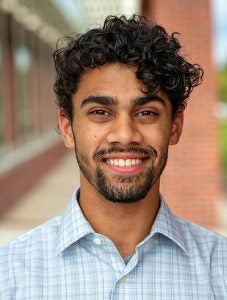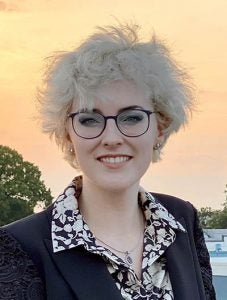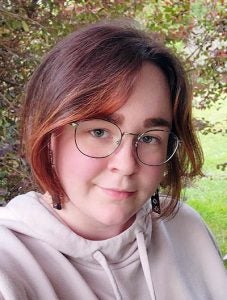ECU engineering students among N.C. Space Grant recipients
Two engineering students are among four students from East Carolina University who have received North Carolina Space Grant undergraduate research scholarships for 2021-22.
Elliot Paul and Nia Wilson, both engineering majors, and Mikayla Dixon and Katherine Foster, both geology majors, will each receive $8,000 to continue their studies and research that relate to the aerospace and aviation fields. They are four of 11 undergraduate students from across the state to receive the scholarships.
“Every year brings a new class of motivated young researchers who always impress us with their projects,” said Jobi Cook, associate director for N.C. Space Grant. “These students certainly carry on that tradition, and we’re excited to follow along on their projects. We’re happy to be a part of their STEM career journeys.”
N.C. Space Grant is a consortium of academic institutions that promote, develop and support aeronautics and space-related science, engineering and technology education and training. The organization partners with NASA, industry, nonprofit organizations and state government agencies to conduct programs designed to equip the current and future aerospace workforce of North Carolina.
Elliot Paul

Elliot Paul (Contributed photo)
When Paul found out he was a recipient, he was honored and extremely thankful.
“I think the N.C. Space Grant is a phenomenal opportunity for curious minds to investigate big, interesting questions,” Paul said. “That is why research fascinates me, and the N.C. Space Grant will enable me to research something that fascinates me for the upcoming academic year.”
The senior biomedical engineering major and EC Scholar plans to use the $8,000 scholarship to research the effects of microgravity on bone remodeling with assistant professor Dr. Ali Vahdati serving as mentor. His goal is to find the best measures to ensure astronauts on mid- and long-term missions do not suffer short- or long-term damage to their bone health.
“I am hoping to learn more about the intricacies of bone, learn innovative new computer modeling techniques and best practices, and to grow as an ever-curious researcher,” he said.
While Paul’s post-graduate career will likely not center on space science, he thinks his research interests align with NASA’s science mission directorate.
“I am most interested in biomechanics and mechanobiology, which can have a wide-ranging impact on many aspects of life from space science to sports medicine and beyond,” he said.
Nia Wilson

Nia Wilson (Contributed photo)
A mechanical engineering senior, Wilson has been working with Dr. Teresa Ryan on acoustical research for the Navy. Her part of that research involves comparing sound loudness based on measuring actual temperature profiles as opposed to temperature models that are currently used.
“Based on the recent findings for the project, it was concluded that the existing temperature profile models are insufficient at capturing the near surface complexities, below about 5 meters,” she said.
Her goals with the scholarship include designing and implementing post-processing code to determine the change in vertical temperature gradient with time.
Wilson said she’s interested in working in aviation and aircraft design.
“I decided to apply for this award because I am interested in pursuing a career in aerospace engineering and potentially working at NASA,” she said. “I believe this is a great opportunity to not only start my career in aerospace engineering, but to also get the youth excited about engineering, NASA and space by sharing my research with them.”
And when she got the news that she had received the scholarship?
“I was really surprised and very excited,” she said. “It is a very prestigious award, and I am very honored to be one of the recipients for it.”
Mikayla Dixon

Mikayla Dixon (Contributed photo)
Dixon, a senior geology student with minors in atmospheric science and art, is working with Dr. Adriana Heimann to analyze water content in olivine minerals from Martian meteorites and compare it to those that contain olivine in Montana and Greenland.
“I am hoping to learn how similar the formation of Mars was to Earth,” Dixon said. “Learning about the past climate of Mars from studying its lithosphere will provide insight about the possible existence of past life on Mars. The rock record will allow us to understand if there may have ever been life on Mars, or it could lead to the discovery of a past Martian biosphere. This research project will allow us to learn more about the hydrosphere of Mars, how much of it is left, and where it could be.”
She said the research could have implications with the future of this planet.
“I am very interested in climate science, and a crucial avenue of predicting possible outcomes of our planet is to study other planets like Mars,” Dixon said “Mars, one of our closest terrestrial neighbors, contains important clues about its past environments within its crust and mantle minerals that can be compared to terrestrial ones.”
Dixon said the research is made possible through use of Martian meteorites from the Smithsonian Museum of Natural History and use of a Ram HR Evolution Raman spectrometer at the Museum of Natural Science.
Katherine Foster

Katherine Foster (Contributed photo)
A senior majoring in geology and biology, Foster is focused on the detection of biosignatures in the form of organic minerals produced by proteobacteria. Basically, it’s fossilized waste of a bacterial colony that no longer exists.
She hopes to analyze the biominerals within a controlled environment, which starts with designing that home environment.
“I hope that my findings will help open the door for astrobiologists to have a way to accurately identify and classify these potential biosignatures,” Foster said. “They’re excellent candidates that can help constrain chemical environments and provide a window into what ‘life’ may appear as.”
Foster said she’s interested in taking her geology degree and applying it to space science. As an example, geologists would play a key role in analyzing samples from the Perseverance Mars mission.
For now, she’s happy for the support of the scholarship.
“It’s a lot of pressure off of you to be able to know you won’t have to worry about the financial end of your studies and classes,” Foster said. “I also can’t wait to begin with community outreach plans and related activities. It will be so exciting to share my findings and further research plans as I progress.”